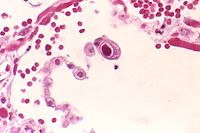
Photo from wikipedia
Abstract Background (Val)ganciclovir resistance mutations (GRMs) in CMV UL97 (UL97-GCV-R) complicate prophylaxis and therapy of solid-organ transplant (SOT) and hematopoietic (stem) cell transplant (HCT) recipients, but data on prevalence and… Click to show full abstract
Abstract Background (Val)ganciclovir resistance mutations (GRMs) in CMV UL97 (UL97-GCV-R) complicate prophylaxis and therapy of solid-organ transplant (SOT) and hematopoietic (stem) cell transplant (HCT) recipients, but data on prevalence and dynamics are scarce. We investigated UL97-GCV-R using next-generation sequencing (NGS) in transplant recipients with refractory CMV DNAemia episodes and a control group. Methods Between January 1, 2010–July 16, 2016, 385 transplant recipients were screened for plasma CMV DNAemia. Eighty-seven patients (54 SOT, 33 HCT) with available plasma samples had refractory CMV replication at viral loads ≥910 IU/mL and were analysed by NGS. If UL97-GCV-R were detected in >10% of the NGS reads, all earlier plasma samples were also analysed by NGS. For comparison, this approach was also performed in a control group of 21 patients (14 SOT, 7 HSCT) with DNAemia episodes resolving under antiviral therapy. UL97-targeted NGS was performed using Illumina MiSeq and analysed by LoFreq for variant calling. Results Of the 87 recipients with refractory CMV replication, 19 (22%) had ≥1 UL97-GCV-R detected by NGS (Table 1, Figure 1), in comparison to 0/21 (0%) of the controls (P = 0.02). Fourteen of 19 of the resistant cases (20 induced mutations) had NGS performed <4 week from onset of infection; in this sample, the mutation was either not detected, detected as minority or dominating variant for 11, 7 and 2, respectively. In the majority of recipients one dominant mutant was induced (68%); ≥2 mutations were detected in the remaining recipients (Table 1). Most frequent UL97-GCV-R affected codon-595 (42%), -594 (32%) or -603 (32%). The % of C592G was low in in all episodes (<15%) without changing during the course (Figure 1). There was a trend toward higher frequencies of donor (D)/recipient (R) CMV high-risk mismatch, CMV disease and prior failure to valganciclovir prophylaxis (SOT) or treatment (HCT) among the cases with UL97-GCV-R (Figure 2). Conclusion UL97-GCV-R was seen in 22% of refractory CMV replication episodes. CMV D/R mismatch and CMV disease were more common amongst resistant cases. The C592G mutation was present in low frequency in all patients, suggesting that this mutation was part of the quasispecies, and not selected by ganciclovir resistance. Implications for clinical management will be discussed. Disclosures All authors: No reported disclosures.
Journal Title: Open Forum Infectious Diseases
Year Published: 2018
Link to full text (if available)
Share on Social Media: Sign Up to like & get
recommendations!